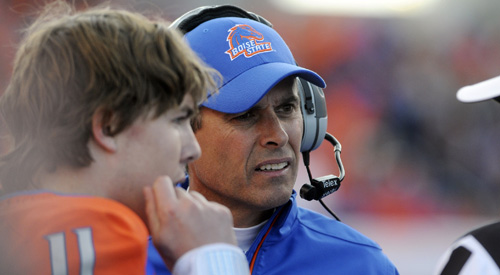
After Kellen Moore, uncertainty reigns for Boise State
Believe it or not, the Boise State Broncos are in a slump. Yep, in this world of “what have you done for me lately?” the Broncos fall considerably short. Chris Petersen’s team might have finished the 2009 season with a perfect 14-0 record and a win in the Fiesta Bowl, but we know what the Broncos haven’t done lately – and that’s winning a conference title.
Because of two losses in the past 26 games, the Broncos haven’t been invited to a BCS bowl since the 2009 season. For a non-AQ team, this is the life in the BCS world. Of course, that’s also the irony of the BCS, because there’s no guarantee that Boise State would have made the title game in either of the past two seasons had its kicker made a field goal at the end of regulation in the team’s lone two losses. Conceivably, the Broncos and their unblemished record would have played in a BCS bowl, but they could have played in one other than the championship game. Yet even the Fiesta or Sugar Bowls still beat the MAACO Las Vegas Bowl twice, right?
Boise State enters this offseason with more uncertainty than usual surrounding the program. Gone are elite quarterback Kellen Moore, running back Doug Martin, left tackle Nate Potter and tight end Kyle Efaw. On the defensive side especially, the losses abound. Losing players like linemen Billy Winn or Shea McClellin will hurt and test the team’s resolve. However, the team will still likely manage. Every year since the arrival of Petersen, the Broncos have been one of the stingiest defensive units in the FBS.
Yet, the biggest loss remains that of Kellen Moore. At six-foot-one and 191 lbs., Moore’s talents on the football field are inversely proportional to his looks off of it, which is another way of saying that he looks just like you, but is much more skilled than you are. The young man from Prosser, Wash., has lost three of 53 career starts by a total of five points while passing for over 14,667 yards.
[php snippet=1]
The Artist lost receivers Titus Young and Austin Pettis to the NFL prior to his senior season, but he has simply played on. Moore doesn’t throw passes as much as he places them on his receivers’ hands, and it works for him, as he’s completed 69.8 percent of his passes with 142 touchdown passes and only 28 interceptions during his career.
That being said, doubt will not be limited to the depth chart for the Broncos. Petersen’s team enters its second and final season in the Mountain West Conference (MWC) before making the jump to the Big East in 2013 as part of an expansion that also includes SMU, Houston, San Diego State and UCF.
There will definitely be some positives to this new status. Boise State’s strength of schedule will get a much-needed boost, meaning that the team won’t need to beat Oregon, Virginia Tech or Georgia in the first week of the season like it did in the past three years. In college football, better scheduling usually means better talent as well. And given Boise State’s proficiency at developing the limited talent that it manages to lure to Idaho, this can only help. Not only will the Broncos be able to sign and develop better players, but the Big East move should also solidify the school’s ties to regions like Texas and California, where Boise State has traditionally recruited well.
Most of all, this move to the Big East will give Boise State the benefit of the doubt. No longer will the team need to win every single game simply to be considered for a BCS bowl berth. Boise State detractors say that the team could never duplicate its 11-1 or 12-0 record in an AQ conference, but that’s a moot point because nobody wins 11 or 12 games every year. All the Broncos want is for their conference title to mean as much as Alabama’s or Oklahoma’s – and the Big East will guarantee that.
This all rests on the notion that the Big East will keep its AQ status once the BCS reassesses the membership of its six conferences after the 2013 season, and whether others are more deserving. The conference could lose out to another conference – say, the MWC – and the Broncos would be back to square one. Judging by Boise State’s lack of history in being accepted as one of the big boys at the BCS dance, fans shouldn’t be surprised if this scenario was to play out exactly as predicted.
Through it all, the common denominator will remain Chris Petersen and his career record of 73-6 at the helm of Boise State. The presence of an elite quarterback in Kellen Moore helped him win plenty of games, but Moore only played the last four years and Petersen has been the team’s head coach since 2006. And remember, he managed to win a Fiesta Bowl with one Jared Zabransky, who later became the reserve quarterback for the CFL’s Edmonton Eskimos at a time when just about everybody could have done as much.
Many middling prospects have come to Boise and left much better prepared for the NFL, owing to the 47-year-old head coach. Petersen even turned one good prospect, two-star recruit Ryan Clady, into an NFL first-round pick and current starter at left tackle for the Denver Broncos.
Until he proves otherwise, Chris Petersen deserves the benefit of the doubt. Still, new starter Joe Southwick had better be a good quarterback if the Broncos are to maintain their run.
[php snippet=1] http://credit-n.ru/zaymyi-next.html http://credit-n.ru/zaymyi-next.html http://www.otc-certified-store.com/surgery-medicine-europe.html https://www.zp-pdl.com

